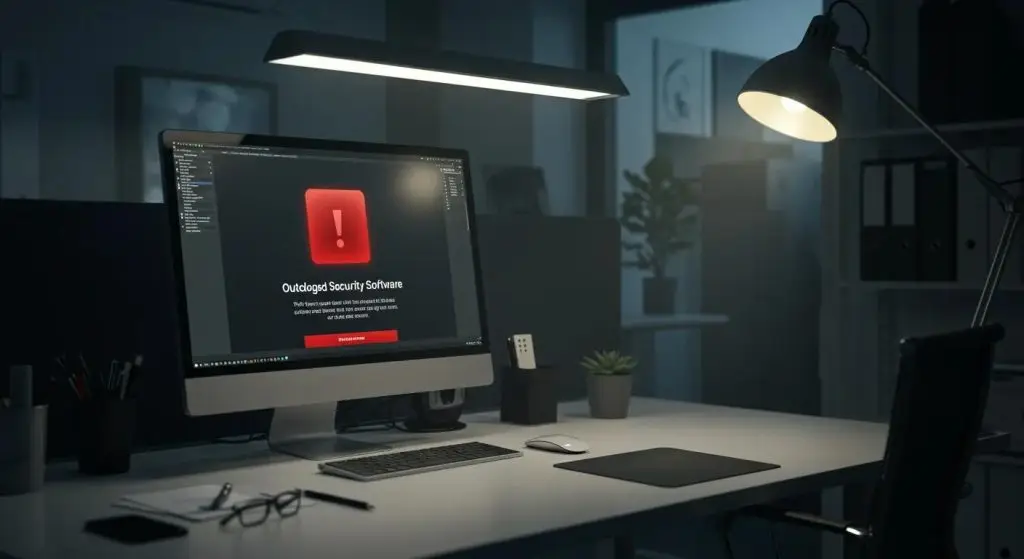Warning Signs Your Security Software Is Falling Behind
10 Warning Signs Your Security Software Is Outdated or No Longer Effective
Introduction
When businesses rely on legacy systems and outdated cybersecurity measures, they expose themselves to increased risks from malware, ransomware, phishing, and other threats. Modern IT environments demand effective security software that not only protects data but also adapts to evolving cyber threats. Outdated solutions can slow down operations, cause data loss, and compromise enterprise architecture. Cybersecurity executives and board-level decision makers, often advised by sheep-dog-vciso professionals, must identify warning signs early to maintain robust defense mechanisms. This article examines 10 critical signs that your security software is no longer effective or is outdated, providing insights grounded in risk management principles. It discusses performance issues, update failures, vulnerability to emerging threats, abnormal behavior changes in software modules, and communication gaps from vendors. By learning these signals, organizations can initiate timely upgrades or consult experts to implement managed-network-firewall-services that align with modern security standards. This approach ensures that both the operating systems and the overall IT infrastructure remain resilient. With increasing complexity in enterprise architecture and supply chain security, a proactive approach is essential. Each major section in this article outlines specific warning signals, supported by quantified data and expert insights, so that businesses can transmit a clear message to their cybersecurity teams. In recognizing early signs such as sluggish performance or repeated update failures, companies gain the autonomy to mitigate risks through targeted interventions and strategic upgrades. As cybercriminals become more sophisticated, a security software product that once served well may become obsolete overnight. With these warning signs in mind, organizations can safeguard their assets and protect their sensitive databases from breaches. Transitioning to effective, updated protection becomes not just a technical upgrade but a strategic business necessity.
Key Takeaways
- Outdated security software may severely impact system performance and responsiveness.
- Failing update mechanisms are a strong indicator that the software is no longer modern.
- Persistent vulnerabilities allow advanced cyber threats to bypass defenses.
- Communication gaps from vendors and end-of-life notices highlight urgent upgrade needs.
- Regular testing and professional audits can confirm the effectiveness of current protection measures.
Identifying Performance Red Flags Indicating Ineffective Security Software

Your Computer Runs Slower Than Usual
One of the first observable red flags is a noticeable reduction in system speed. When security software hijacks significant system resources, overall performance suffers, leading to delayed responses and increased reboot times. The slowdown may result from outdated scanning engines or inefficient algorithms that are incapable of processing modern threats. Data from IT infrastructure studies reveal that legacy systems can experience up to a 40% decrease in processing speed compared to updated security solutions. Business users have reported experiencing longer load times on enterprise applications and slower access to critical databases. This performance degradation not only affects productivity but also risks delay in executing time-sensitive operations, potentially compromising the organization’s ability to mitigate high-priority threats in real time.
Frequent Software Crashes or Freezes Point to Problems
When security software consistently crashes or freezes, it undermines user confidence and disrupts essential operations. Frequent software failures can lead to unplanned downtime, hampering routine business meetings, asset management tasks, and data backup processes. In modern IT environments where every minute matters, such instability signals that the software may not be optimized for current operating systems or applications. Enterprises operating with legacy versions may observe that error messages and system logs frequently indicate process termination due to incompatibility issues. Ultimately, consistent instability can obstruct the reliable delivery of real-time protection, thereby increasing the risk of data loss and vulnerability exposure.
Security Scans Take an Unusually Long Time to Complete
An effective security solution should complete scans within a reasonable time frame without excessively impacting other applications. However, when full system scans extend well beyond their typical duration, it is a sign that the scanning engine is either overburdened or inefficient. Outdated virus definitions and outdated heuristics in legacy systems can contribute to this delay. For example, while modern scanners might complete an extensive scan in under 30 minutes, older systems can take several hours, thereby reducing operational efficiency. As business data and file sizes increase, expecting prolonged scan times becomes unrealistic and can lead to critical delays in threat detection and remediation.
Unexpected System Resource Drain by Security Programs
Unexpected fluctuations in system resource usage can be linked to background processes initiated by outdated or malfunctioning security software. When CPU and memory usage spike unexpectedly—even when no intensive tasks are running—employees may experience degraded performance across various applications. Studies in the field of managed IT services have noted that inefficient security protocols can consume up to 30% more resources compared with modern counterparts. This inefficiency can lead to reduced capabilities in executing simultaneous tasks, potentially causing interruptions during crucial presentations or virtual meetings.
How Do I Know if Sluggishness Means My Security Software Is Outdated
If your system consistently runs out of resources or exhibits performance lags despite regular maintenance and updates to other software components, these could be tell-tale signs that your security software is outdated. When such sluggishness is observed in comparative benchmarks or through internal performance monitoring tools, it verifies that the current solution no longer meets the operating standards required for effective cybersecurity. Enterprises frequently report that such delays correlate with security patches or updates that are not up-to-date. Therefore, regular performance audits should be integrated with IT risk management to determine whether a software upgrade or a shift to managed-network-firewall services is necessary.
Recognizing the Warning Signs Your Security Software Is Outdated Through Update Failures

Automatic Updates Cease or Consistently Fail
Security software vendors typically release regular updates to counter emerging vulnerabilities. When updates automatically cease or fail repeatedly, it is an immediate warning sign that the software might have reached its end-of-life. Businesses relying on such software may notice error codes or the absence of update notifications, leading to security gaps and data loss risks. In this scenario, consistency in update failure signals poor vendor support and unsustainability in defense mechanisms. This is especially significant in environments where rapid patching is essential to counter vulnerabilities like those exploited by ransomware.
Manual Update Attempts Result in Errors
Even when automatic updates fail, manual intervention may be attempted by IT administrators. If these manual updates consistently result in errors or partial installations, it indicates compatibility issues with current operating systems and underlying database structures. Such repeated failures may suggest that the security software is no longer maintained or updated to meet modern cybersecurity standards. For instance, errors during manual patching might include compatibility warnings with newer hardware drivers, leaving systems exposed to further risks. This not only raises operational concerns but also questions the overall credibility of the legacy system.
Virus Definitions Are Not Current
For antivirus programs, virus definition databases must be continuously updated to recognize and neutralize the latest malware strains. Outdated virus definitions result in reduced detection accuracy and an increased likelihood of penetration by new threats. Research shows that an outdated virus definition can lower detection rates by as much as 25%. In enterprises using legacy systems, IT teams might find that the software’s definitions lag behind industry standards, meaning the solution cannot recognize recent variants of ransomware or zero-day exploits. This gap emphasizes the importance of adopting up-to-date security solutions to ensure comprehensive protection.
Notifications About Lapsed Subscriptions or Obsolete Versions Appear
When end users receive notifications regarding lapsed subscriptions, outdated versions, or prompts about the possibility of upgrading their software, it is a clear indicator from the vendor. These messages are often accompanied by warnings that critical features or new threat intelligence will no longer be supported. Such notifications should not be ignored because they undermine user trust and point toward obsolete protection. A well-supported security system must always be in a state of readiness to protect against the latest cyber threats, making it imperative to address these warnings immediately.
Your Software No Longer Receives Support for New Operating Systems
Technology platforms and operating systems continually evolve, and security software must be compatible with these changes. If your security software is not optimized or fails to integrate with new operating systems, it indicates that the solution is outdated. This lack of support can disrupt updates, cause compatibility issues, and ultimately leave the system vulnerable against current malware trends. IT departments must regularly verify whether their security software is receiving the necessary vendor support to handle new system integrations. Failure to do so can be particularly disastrous in environments where uptime and data integrity are of the utmost importance.
Spotting Ineffective Protection When Cyber Threats Bypass Your Defenses

Malware Infections Occur Despite Active Security Software
An alarming indicator that security software is no longer efficient is the occurrence of malware infections even when the software is active and supposedly up-to-date. When malicious software repeatedly bypasses the protective measures, it reflects outdated threat-detection algorithms and insufficient response protocols. In many cases, infected systems report multiple breaches that the security software fails to contain, which can be verified through log analyses and incident reports. This undermines organizational resilience and necessitates an urgent review of the existing solution’s capabilities.
Suspicious Pop-Ups and Redirects Persist
Frequent pop-ups, intrusive ads, or unsolicited redirects even when the security software is running can be symptomatic of ineffective protection. These anomalies are often indicative of compromised browser add-ons or an inability of the software to effectively block harmful scripts and cyber phishing tactics. Persistent interruptions in user sessions may reduce productivity and also serve as external signs of security vulnerabilities. These patterns not only reflect on the software’s outdated defense mechanisms but also potentially signal the presence of advanced persistent threats penetrating the organization’s network infrastructure.
Your System Exhibits Symptoms of a Compromise
When system behaviors such as unauthorized login attempts, unusual network traffic, or unexpected file modifications are observed, the security software may be failing to detect and prevent these compromise attempts. Such symptoms include strange processes running in safe mode or unexpected changes in user permissions, all of which suggest a breach of security controls. Regular system audits and real-time monitoring help in establishing a baseline of normal operations; deviations from this baseline are strong indicators of effective violations by cyber adversaries. Timely detection and understanding of these symptoms are crucial for effective risk management.
How Do I Know if My Security Software Is No Longer Effective Against New Threats
The effectiveness of any security solution can be measured by its response to emerging cyber threats. When new forms of malware, phishing schemes, or ransomware attacks bypass the defenses, it becomes evident that the installed software is unable to contend with modern attacks. Comparative tests from independent security labs frequently demonstrate that older security products have significantly lower protection ratings against sophisticated threats. Businesses should ensure that their solution not only passes routine compliance tests but also adapts to rapidly evolving attack vectors.
Ransomware or Spyware Is Detected by Other Means
If alternative detection methods—such as secondary scanning tools or managed-it-services audits—reliably identify ransomware or spyware while the primary security software fails to do so, this discrepancy is a major red flag. It suggests that the legacy systems may have obsolete scanning engines or inadequate heuristic analysis. Cybersecurity experts and IT consultants often recommend parallel evaluation using reputable third-party testers to identify such deficiencies, thereby substantiating the need for an immediate upgrade in the security framework.
Observing Changes in Software Behavior That Signal Outdated Protection

Security Software Features Become Unresponsive
When key features like real-time scanning, firewall integration, or threat analytics within the security software become unresponsive or slow to initiate, it signals that the underlying code has not been updated to cope with current cyber threats. Such unresponsiveness not only hampers operational efficiency but also exposes the system to vulnerabilities during critical moments. IT administrators may notice that actions requiring immediate attention—such as emergency patch deployments—are delayed. This lag in response undermines the solution’s ability to safeguard enterprise assets, urging a review of the software vendors’ support lifecycle.
Settings Revert or Cannot Be Modified
An outdated security solution may exhibit issues wherein user-defined settings revert to default configurations or become inaccessible for modifications. This unexpected change implies that the software is not fully integrated with current operating system APIs or updates, thus making it incompatible with business-specific configurations. As a result, customized settings—vital for a company’s risk management and compliance protocols—cannot be preserved. Organizations that depend on tailored security profiles to meet regulatory standards may experience compliance risks, further emphasizing the need to consider upgrading to systems that offer stable, customizable options.
The User Interface Appears Glitchy or Outmoded
An obsolete graphical user interface (GUI) often reflects deeper issues within the software’s architecture. A glitchy, outdated, or clunky interface can lead to misconfigurations and an overall inefficient user experience. When employees struggle to navigate settings or access critical alerts due to poor design, it becomes evident that the solution lacks modern usability features. Updated security software should not only be effective but also user-friendly, ensuring that alerts, logs, and protection controls are accessible with ease. A dated user interface is often paired with a lack of innovative features required by today’s dynamic IT infrastructures.
You Receive Alerts That Your Security Is Turned Off
Receiving frequent, unsolicited alerts that the security software is disabled or turned off can indicate internal failures within the software’s self-monitoring modules. These notifications might stem from errors in the software’s internal scheduler or compatibility issues with new operating systems. Such inconsistencies generate confusion among end users and increase the risk of unmanaged exposure to potential threats. When the software’s core functions are reported as inactive despite being installed and seemingly configured correctly, it becomes a critical sign that the solution’s operational integrity is compromised.
Difficulty Accessing Support or Help Resources
When users experience significant challenges in contacting vendor support, accessing updated documentation, or utilizing online help resources, it is an indication that the security software may be in its end-of-life phase. Vendors typically phase out support for older products, leaving users to rely on outdated manuals and community forums that may not address current cyber threats. This lack of support can leave enterprises ill-equipped to manage incidents, ultimately exposing them to prolonged vulnerabilities. Ensuring that support channels remain active and robust is crucial for maintaining effective protection against emerging security challenges.
Understanding Communication Gaps and End-of-Life Notices
Your Provider Announces End of Support for Your Software Version
When the vendor explicitly announces that a particular software version will no longer be supported, it serves as a clear indicator that continuing to use that solution may pose significant risks. End-of-support announcements demonstrate that no further patches, threat intelligence updates, or technical support will be provided for the product. This situation can lead to exposure to vulnerabilities and inefficiencies, as the software cannot defend against new-age cyber threats. Such communications may appear in official vendor communications or product documentation, and businesses should immediately review their IT infrastructure for potential upgrade or replacement strategies.
You Stop Receiving Regular Security Bulletins or News
Effective cybersecurity depends on timely, proactive communication from the vendor regarding emerging threats, best practices, and software updates. When a company stops receiving these security bulletins, emails, or news announcements, it is a strong sign that the product is being deprecated. Regular communication is vital for keeping a system aligned with modern security standards; hence, lack thereof implies that the security software is not being actively maintained. IT professionals should interpret such lapses as a prompt to consider alternative solutions that are consistently updated.
The Software Is No Longer Available for Download or Purchase
If prospective users and current customers find that the software is no longer available on the vendor’s website or through authorized purchase channels, it likely indicates that the product has been phased out. Inaccessibility to newer versions or add-ons typically follows end-of-life declarations, leaving organizations with unsupported legacy systems. This gap can also be highlighted by removal of online resources, forums, or update patches that would normally be readily available. Such a scenario simply reinforces the need for an immediate migration plan to newer, supported cybersecurity solutions.
Compatibility Issues Arise With New Applications or Hardware
As operating systems and enterprise hardware continuously evolve, legacy security software often struggles to keep pace due to incompatibility issues. When new applications or hardware integrations begin to cause conflicts with your existing security solution, it indicates that the software is not adapted to modern architectures. This may lead to crashes, increased vulnerability, or overall reduced performance of IT infrastructure. Compatibility issues not only affect daily operational efficiency but also increase the risk of cyberattacks, emphasizing that upgrades or replacements in security systems are essential to maintaining robust protection.
Identifying When Your Security Product Reaches Obsolescence
The final warning sign in this category involves a gradual deterioration in the security product’s overall capabilities and support lifecycle, which can be identified by observing the combined impact of end-of-support announcements, lack of updates, and obstacles to integration with new technologies. When these factors converge, the product has effectively reached its obsolescence. Businesses must monitor both internal performance metrics and external vendor communications to determine when it is no longer tenable to rely on the current system. Such strategic decisions are necessary to avoid costly breaches and to ensure that security measures evolve in tandem with new cyber threats.
Steps to Determine if Your Security Software Is Truly Ineffective
Perform a Full System Scan With a Reputable Second-Opinion Scanner
A practical step in assessing the effectiveness of your security software is to perform a comprehensive system scan using an independent, trusted scanning tool. Utilizing a second-opinion scanner provides an unbiased evaluation that can reveal vulnerabilities or malware that your current software might be missing. Such tests help confirm whether the primary security suite is underperforming and allow cybersecurity professionals to compare detection rates and performance metrics. Regular third-party scans are recommended by cybersecurity experts as a critical part of an overall risk management strategy.
Check the Software Manufacturer's Website for Product Status
The next step involves verifying the current status of your security software through the manufacturer’s website. Reliable vendors will provide clear notices regarding end-of-life (EOL) dates, support policies, and upcoming updates. If the website indicates that your version is no longer supported or that updates are no longer available, this is a strong indicator that the product has become outdated. IT departments can rely on this information to make informed decisions on whether to upgrade or replace their current solution.
Review Recent Security Test Results From Independent Labs
Independent security testing laboratories frequently provide benchmark assessments and public reports that highlight the performance and effectiveness of various security software products. Business owners and IT managers should review these reports to gauge if their current system meets modern protection standards. Test results that reveal lower detection rates, slower scan times, or ineffective threat neutralization compared to competitive products serve as a technical validation that the software may be inadequate. Using these empirical data points reinforces the need for potential system upgrades.
Assess if Your Software Protects Against Current Phishing Tactics
Phishing remains one of the most common and successful attack vectors used by cybercriminals. An effective security solution should be able to rapidly identify and neutralize phishing attempts. Evaluate if your software provides adequate protection features such as real-time URL scanning, sender reputation analysis, and heuristic algorithms specific to phishing fraud. If your organization continues to become a target of phishing campaigns or if employees report frequent phishing emails bypassing the software’s filters, then this is a critical sign that the security solution is outdated and needs an upgrade.
Seek Professional Advice if Doubts About Protection Persist
Finally, if there is any doubt about whether your security software is effectively protecting the organization, it is recommended to consult a cybersecurity expert or managed-it-services provider. Professionals can conduct detailed audits, perform penetration tests, and offer tailored recommendations based on your specific IT infrastructure and organizational risk profile. Relying on expert advice ensures that your security measures are not based solely on anecdotal evidence but are supported by rigorous testing and industry best practices.
Frequently Asked Questions
Q: How can outdated security software affect productivity? A: Outdated software often consumes excessive system resources, causing slowdowns and frequent crashes. This not only hinders employee productivity but also delays critical processes, potentially resulting in significant operational disruptions.
Q: What are the risks of not updating virus definitions regularly? A: Failing to update virus definitions leaves systems vulnerable to new malware strains and zero-day exploits. This decreases detection accuracy and increases the likelihood of undetected breaches, ultimately resulting in potential data loss and increased risk of ransomware attacks.
Q: Why is it important to monitor software update failures? A: Monitoring update failures can reveal underlying issues with compatibility and vendor support. Such failures are a clear indicator that your software may be ending its support lifecycle, necessitating immediate evaluation of alternative solutions to maintain effective cybersecurity.
Q: How do compatibility issues indicate outdated security software? A: Compatibility issues occur when older security solutions do not integrate well with new hardware or operating systems. These issues can result in system instability, delays, or even crash incident reports, directly impacting the organization’s overall security posture.
Q: What steps should be taken if a security scan indicates weaknesses? A: If independent scans reveal that your security software is missing threats, organizations should immediately consult with cybersecurity professionals, review vendor policies for support status, and consider upgrading to a more modern, supported solution that aligns with current cyber threat landscapes.
Final Thoughts
The warning signs of outdated security software are clear markers that it may no longer offer robust protection in today’s fast-evolving cyber landscape. From noticeable performance slowdowns and frequent update failures to repeated malware infections and compatibility issues with new systems, each signal demands prompt evaluation and, ultimately, decisive action. Businesses must ensure that every aspect of their IT infrastructure is safeguarded against emerging cyber threats by regularly conducting independent audits and keeping their security measures up-to-date. Engaging expert guidance from cybersecurity consultants can add immense value by tailoring a comprehensive upgrade strategy that minimizes vulnerabilities and protects critical data assets.




